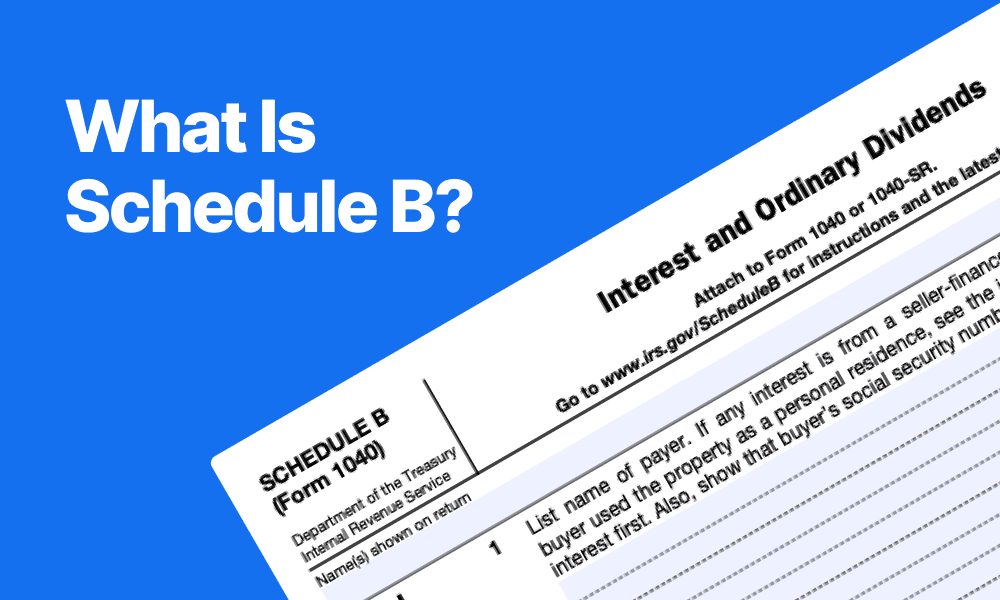What Is Schedule B (Form 1040) and Who Needs to File It?

What Is Schedule B (Form 1040)? Who Needs It and Why
When tax season rolls around, many taxpayers receive Form 1099-INT or Form 1099-DIV. But did you know that if your interest or dividend income passes a certain threshold, you'll also need to file Schedule B (Form 1040)?
At TAXtical LLC, we help individuals and small businesses understand which IRS forms they need and how to file them correctly to avoid penalties or audits.
What Is Schedule B (Form 1040)?
Schedule B is a supplemental tax form used to report taxable interest and ordinary dividend income. It is filed alongside your Form 1040 when your investment income exceeds a specific amount.
You’ll use Schedule B to:
Itemize each source of interest and dividend income
Report any foreign accounts or trusts
Help the IRS verify that you’ve disclosed all taxable investment income
When Do You Need to File Schedule B?
You need to file Schedule B if either of the following is true:
| Type of Income | Threshold for Filing Schedule B |
| Interest Income | More than $1,500 in a year |
| Ordinary Dividends | More than $1,500 in a year |
| Foreign Accounts | You had a foreign bank or trust account |
If your combined total interest and dividend income is under $1,500, you don’t need to file Schedule B—just report it directly on Form 1040 (Line 2b and 3b).
Common Sources of Interest & Dividends Reported on Schedule B
🔹 Interest Income (Reported on 1099-INT)
Bank savings accounts
CDs (Certificates of Deposit)
U.S. Treasury bonds
Corporate bonds
Credit union dividends
🔹 Dividend Income (Reported on 1099-DIV)
Stock dividends from brokerage accounts
Mutual fund payouts
REIT (Real Estate Investment Trust) distributions
Note: Only ordinary dividends go on Schedule B. Qualified dividends are still reported on Form 1040 but are taxed at different rates.
Foreign Accounts and Schedule B
Part III of Schedule B asks:
"At any time during the year, did you have a financial interest in or signature authority over a financial account in a foreign country?"
If you answer yes, you're required to:
Disclose the country where the account is located
File FBAR (FinCEN Form 114) if the total foreign account value exceeds $10,000 at any point during the year
Possibly file Form 8938 (FATCA) if thresholds are met
What Information Goes on Schedule B?
Here’s what you’ll report on Schedule B:
Part I: Interest Income
List each source and the amount received
Total your interest income
Part II: Ordinary Dividends
List each dividend-paying source
Total your ordinary dividends
Part III: Foreign Accounts/Trusts
Answer questions about foreign financial interests
Identify any relevant countries
⚠️ What Happens If You Don’t File Schedule B When Required?
If you fail to file Schedule B when required, you may:
Trigger an IRS notice or audit
Owe back taxes, penalties, and interest
Face serious consequences for failing to disclose foreign accounts, including civil penalties or even criminal charges
✅ Why Choose TAXtical LLC to Help With Schedule B?
Filing taxes with investment income and foreign accounts can get complicated fast. That’s where we come in.
📌 Expert Review of All 1099s – We'll help you gather and organize all 1099-INT and 1099-DIV forms
📌 Foreign Disclosure Compliance – Ensure you're in full compliance with FBAR and FATCA rules
📌 Audit Protection – We prepare your return accurately to minimize your audit risk
📌 Nationwide Support – Offices in Baton Rouge, Utah, South Carolina, and Michigan
📌 Transparent Pricing – No hidden fees. Ever.
📞 Need Help Filing Schedule B?
Whether you’re reporting interest from your savings account or dividends from your brokerage account, TAXtical LLC is here to make tax season stress-free.
👉 Contact us today for a free consultation and professional tax filing support tailored to your needs.

